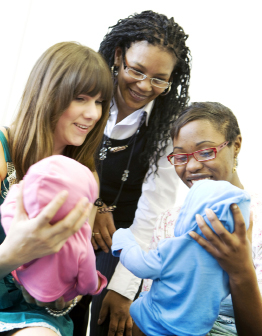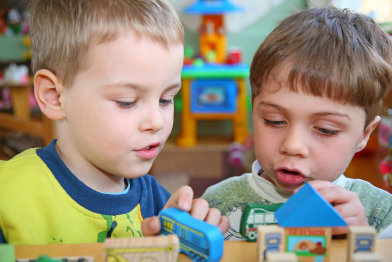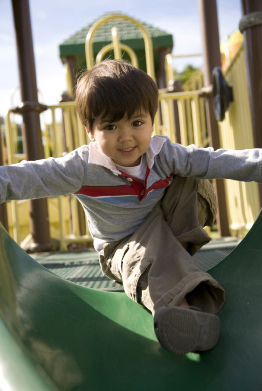Inquiry 2
| Site: | MoodleHUB.ca 🍁 |
| Course: | Early Learning and Child Care 30 Modules |
| Book: | Inquiry 2 |
| Printed by: | Guest user |
| Date: | Thursday, 18 December 2025, 10:34 AM |
Description
Created by IMSreader
1. Inquiry 2
Session 1: The Importance of Child Care Providers
Inquiry 2: What Is Quality Care?

© track5/iStockphoto
Quality child care supports a child’s emotional, social, intellectual, creative, and physical development needs.
Children have many characteristics in common as they grow, but it is important to understand that each child is unique and requires different attention levels. Some children are born with conditions or disabilities that may require extra or different attention from child care providers. Some children may have slight delays in learning and they may catch up later, while others may always be delayed. All children have the right to participate in programs that help them to grow and learn to their maximum potential.
Child care providers are a key component to supporting quality care. To provide quality care, child care providers must do the following:
- understand how children grow and learn
- be affectionate and responsive, open and informative
- provide a stable and stimulating environment
- seek out community resources and support
Ensuring quality child care means meeting each child’s emotional, social, intellectual, creative, and physical development needs.
Canadian Child Care Federation. Resource Sheet #34 (Making a Quality Child Care Choice). <http://www.cccns.org/pdf/b2b.pdf>; (15 June 2009). Reprinted by permission.
Developmental Areas
The following is a brief overview of five developmental areas. You will have opportunities to learn more about children’s physical and intellectual development in CCS3120; and children’s social, emotional, and creative development in CCS3130.
Meeting Children’s Emotional Needs
A child’s emotional needs are being met when the following occurs:
- The child’s sense of self-esteem is fostered through encouragement.
- The child experiences independence, success, and fun.
- The child’s feelings are accepted.
- The child has opportunities to develop his or her own unique creativity.
- The child is provided with flexible yet predictable routines that include realistic expectations and boundaries.
- The child receives positive guidance.
- The child’s cultural differences are respected.
- The child can express pride in his or her cultural diversity.
- The child’s learning of language is encouraged and supported.
- Input from the child’s parent(s) and/or guardian(s) is encouraged and respected.
- The child has opportunities to share her or his growth and development with the child’s parent(s) and/or guardian(s).
Meeting Children’s Social Needs

© Perkmeup Imagery/iStockphoto
A child’s social needs are being met when the following occurs:
- The child’s development is encouraged through play.
- The child has freedom to interact and develop relationships with other children and child care providers.
- The child experiences an environment in which co-operation is encouraged.
- The child has opportunities for solitary, small group, and large group experiences.
- The child knows the routines and boundaries and can trust that these rules and boundaries will be upheld consistently.
- The child feels guidance from the child care provider and is encouraged to take responsibility for actions.
- The child is guided toward appropriate behaviour.
- The child can express ideas, views, and opinions and has input into decisions.
- The child has opportunity for quiet and active times and indoor and outdoor play.
- The child can choose to participate or not.
- The child has plenty of play materials.
- The child has child care providers who are good role models and who are sensitive to the child’s developmental needs.
- The child is free from gender stereotyping.
- The child has child care providers who understand the developmental needs of children.
Meeting Children’s Intellectual Needs

© 2009 Jupiterimages Corporation
A child’s intellectual needs are being met when the following occurs:
- The child has experiences geared to her or his developmental level and is encouraged to learn through play.
- The child has opportunities to explore.
- The child feels a balance of solitary, small group, and large group learning activities.
- The child experiences a balance of interesting activities in which he or she is exposed to science, math, social studies, language and literature, music, art, and physical education.
- The child can spontaneously choose how and what to play with and also participates in activities planned and organized by the child care provider.
- The child can play with a variety of easily accessible toys and equipment.
- The child feels comfortable and relaxed.
- The child interacts with child care providers who are warm, practical, involved, patient, and have a sense of humour.
- The child has opportunities to be challenged intellectually, to progress at the child’s own developmental rate, and to reach the child’s full potential.

© James Tutor/iStockphoto
Meeting Children’s Physical Needs
A child’s physical needs are being met when the following occurs:
- The child’s safety is ensured through a child care provider’s close supervision.
- The child is comforted when necessary.
- The child is free from physical or psychological abuse.
- The child can choose privacy when toileting.
- The child has opportunities for active and quiet, individual and group play.
- The child is exposed only to conditions that promote good health (e.g., sanitary conditions, nutritious meals and snacks).
- The child experiences comfortable, inviting, spacious play areas that include, but are not limited to, the following interest areas: block corner, playhouse, science area, library, music corner, art area, and large-muscle equipment.
- The child has outdoor and indoor play that includes opportunities for climbing, digging, running, and so on.
- The child has a comfortable space for sleep time, if applicable.
Canadian Child Care Federation. Resource Sheet #3 (The Child’s Rights in a Preschool Setting). Originally written by Mr. Justice Warren E. Berger in Social Work, Spring 1979 and adapted by the British Columbia Preschool Teachers’ Association from The Child’s Rights in a Preschool Setting: A Position Paper, 1981.
<www.ccns.org> Reproduced with permission.
Meeting Children’s Creative Needs

© Jaimie Duplass/123RF Limited
A child’s creative needs are being met when the following occurs:
- The child is asked open-ended questions that require creative responses.
- The child can choose from a variety of age-appropriate materials and can use the materials in a way that he or she wants.
- The child has lots of time to experiment with a variety of materials so that she or he can explore them in depth.
- The child can engage in different types of creative activities.
- The child can move easily from one activity to another.
- The child is encouraged and supported to think and express himself or herself in different ways.
- The child is encouraged and supported to use all senses through a variety of play materials and experiences.
Checking My Understanding
Making Choices as a Child Care Provider
Focus
It is essential that all child care providers have a strong commitment to encourage children’s development and to protect them from harm.
Perhaps one of the most important challenges for child care providers is to be able to focus on an individual child while keeping an eye on a group of children at the same time. It is very important that you have a keen eye for prevention and a position in the child care area from which you can carefully watch and respond to all children in your care.
Directions
It’s time to check your understanding of meeting children’s emotional, social, intellectual, creative, and physical developmental needs. Complete the interactive activity “Developmental Needs.”
1.1. Learning Activity 2
Session 1: The Importance of Child Care Providers
Learning Activity 2: How Is Quality Care Achieved?
Focus
Children’s best possible development is supported when the quality of their care is high. By completing this learning activity, you will have the opportunity to understand further how to achieve quality care in child care programs.
In this three-part learning activity, you will complete the following:
- construct interview questions
- interview someone working in a child care facility who has either a Child Development Worker or Child Development Supervisor certificate
- reflect on your learnings
Step 1: Open Learning Activity 2: How Is Quality Care Achieved? With a classmate, complete Part 1 of the activity sheet.
Important: When assessing the quality of your work in the Student Rubric, use the checkboxes to indicate where you think your work fits (i.e., in each row, you will check either Master/Expert, Proficient, Acceptable, or Emerging).
Step 2: Review Part 1 of the Student Rubric for Learning Activity 2: How Is Quality Care Achieved? Assess the quality of your interview questions and make any necessary adjustments.
Step 3: Arrange a time to interview someone working in the child care facility who has either a Child Development Worker or Child Development Supervisor certificate.
Step 4: Meet with the person and record the person’s responses to your interview questions in Part 2 of Learning Activity 2: How Is Quality Care Achieved?
Step 5: With your partner, discuss the responses given by each interviewee.
Step 6: Complete Part 3 of Learning Activity 2: How Is Quality Care Achieved?
Step 7: Review the Student Rubric for Learning Activity 2: How Is Quality Care Achieved? Assess the quality of your written reflection from Part 3 and make any necessary adjustments.
Checking In
Important: Your “self-assessment” is the student rubric you completed.
Save a copy of your interview questions, your completed learning activity, and your self-assessment in the appropriate sub-folder of your course folder.